I work at Library and Archives Canada and my first job there, more than 30 years ago as a summer student, was in the motion picture section, in the nitrate vaults. These vaults were in fact an old munitions storage bunker out on an airforce base. The building had a series of long narrow rooms and film cans were stored only on one side so that if there was a fire, the heat on the wall would not ignite the cans in the next room, or at least so it was hoped.
On the first day, one of older guys who had worked with nitrate for years took us outside for a demonstration on the handling of nitrate film. He took a long piece of nitrate stock and put it in a big drum filled with sand. Man, it lit up like huge torch, way out of proportion to the amount of film. "By the way," he added, " you can't put it out with water. Don't smoke in the building. Ever." It scared the bejeezus out of all the summer students and we walked on eggshells the whole time we were there.
On the positive side, you have not really seen a classic b&w Hollywood film until you have seen a nitrate print projected. It is only then that you understand the source of the phrase "silver screen." They are absolutely luscious and if you know photography, you are particularly impressed (and humbled) by the craft of those cinematographers. As someone else pointed out, a stable nitrate print, with no evidence of deterioration, is quite safe to project with the right equipment.
.)









